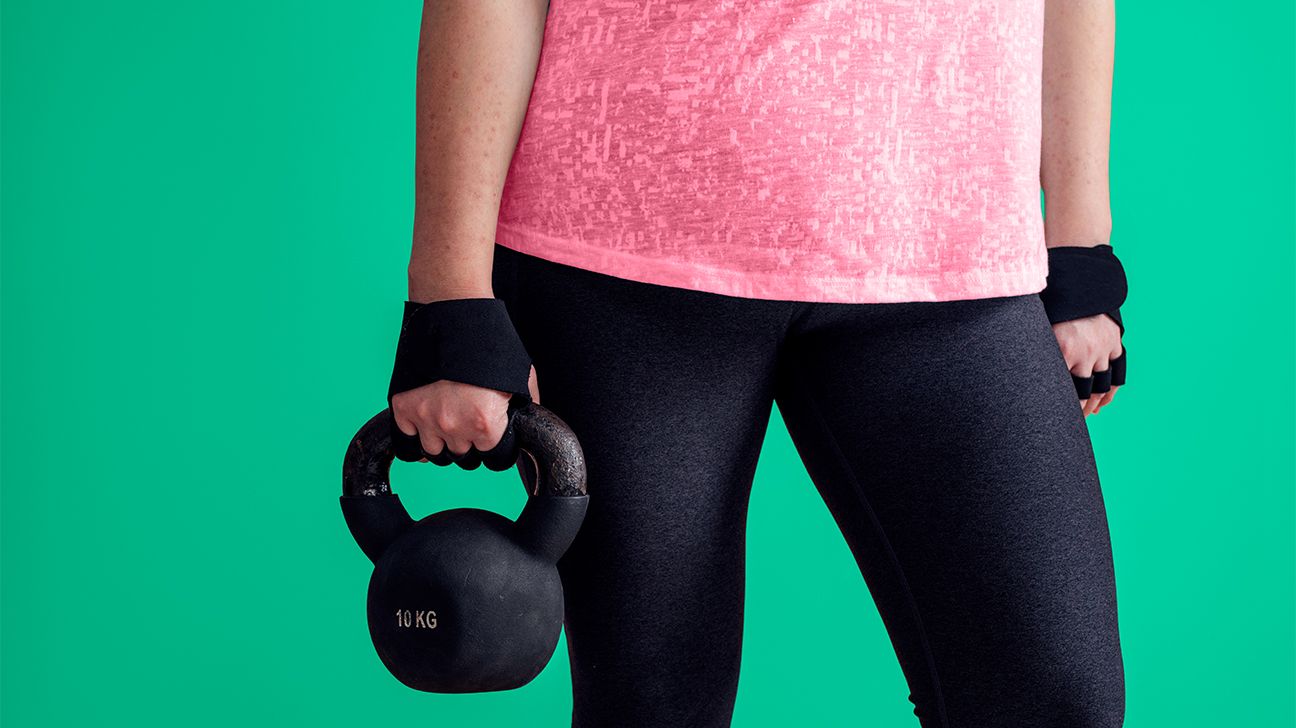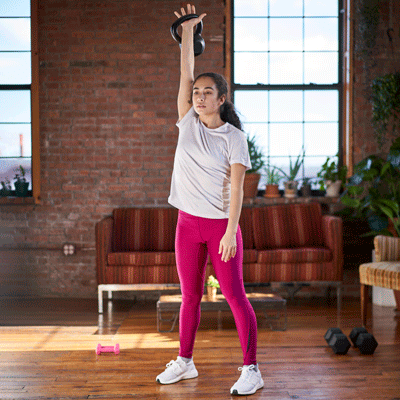A kettlebell snatch is a full-body exercise you can perform just about anywhere. Learn how to perform this simple but effective move.
Compact and convenient, a kettlebell is a great addition to your at-home or gym-based workouts. This little weight shaped like an old-timey alarm clock (or slightly wonky Mickey Mouse head) offers benefits for strength while being easy to grip and maneuver. One popular exercise to do with it is the so-called “snatch.”
Read on to learn how to master the kettlebell snatch, plus its potential benefits for your bod.

A kettlebell snatch isn’t complicated, but it may take a few tries to master. Here’s a step-by-step guide!

- Starting position: Stand with your legs hip-distance apart and place the kettlebell between your feet.
- Grip and initial swing: Lean your weight back into your hips, as though about to sit in a chair (but not as far as a full squat), and grab the kettlebell handle with the fingers of one hand.
- Swing back: Swing the kettlebell back between your legs with one hand, keeping your other hand free.
- Raise overhead: In one swift motion, raise the kettlebell overhead as you return to standing upright. As the kettlebell reaches shoulder height, shrug your shoulders and loosen the grip of your fingers so the handle slides into your palm. Let the momentum of your movement swing the kettlebell up and around, coming to rest on the back of your hand.
- Complete the press: Unshrug your shoulders as the kettlebell rounds your hand and come into an overhead press position with arms, hips, and knees fully extended.
- Return to start and repeat: Briefly hold the overhead press. Then, swing the kettlebell down in front of you, transitioning smoothly to the starting swing position. This completes one full repetition.
FYI: After completing a set on one side, switch arms and repeat the exercise to ensure balanced strength and muscle development on both sides.
Repetitions and sets
Aim to perform 8–10 repetitions per set. Start with 3 sets per arm. Ensure to perform all the reps on one arm before switching to another.
Here are some common mistakes to be aware of.
- Starting with too heavy a weight: Start with a lighter weight to get the hang of the movement without straining too much. Consider something on the smaller side first, then work up to a heavier kettlebell.
- Crunching the neck: It’s easy to crane or crunch your neck as you shrug your shoulders to haul the kettlebell above your head. Keep your chin down rather than tilting it up to protect the neck.
- Holding your breath: We get it — kettlebell exercises take concentration. But focusing so much that you don’t breathe is a bad idea. Try inhaling as you swing upward, then exhaling when you reach extension.
There’s always a way to make your snatch workout a little easier (or a little harder). If you want a more advanced kettlebell challenge, use a heavier weight. Or try a “dead snatch.” In this variation, you’ll haul the kettlebell overhead without the momentum of the initial between-the-legs swing. Then return the weight all the way to the ground after each rep.
- If you have high blood pressure or another cardiovascular condition, are pregnant, or have problems with your wrists or fingers, check in with your doctor before starting any kettlebell workout.
- Use chalk or gloves to minimize the risk of slippage, especially if your hands sweat when lifting weights.
- Before you begin, watch videos that show proper form — or better yet, consult a certified personal trainer who can walk you through the movements involved.
- Again, start with a lighter weight to minimize the risk of injury.
Here are four reasons to add a kettlebell snatch to your workout:
- Better range of motion in the shoulders: The full arc of shoulder movement promotes joint mobility and flexibility.
- Increased grip strength: With each snatch, your fingers work hard to maintain a steady grip.
- Core stability: Strong core engagement gives you the power you need to swing the kettlebell up and over your head.
- More aerobic power and muscle strength: A 2019 study found that kettlebell exercises increased aerobic capacity and strength when used in resistance-based circuit training workouts.
- Greater coordination: In a kettlebell snatch, a lot is happening in your body and brain, improving your overall coordination.
Kettlebell snatches have much to offer as part of a strength training routine. They engage multiple muscle groups, challenge your coordination, and require just a single piece of equipment. We say snatch up these benefits!

